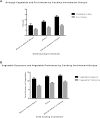The Association Between Child Cooking Involvement in Food Preparation and Fruit and Vegetable Intake in a Hispanic Youth Population
- PMID: 32258989
- PMCID: PMC7108796
- DOI: 10.1093/cdn/nzaa028
The Association Between Child Cooking Involvement in Food Preparation and Fruit and Vegetable Intake in a Hispanic Youth Population
Abstract
Background: Cooking interventions have been linked to reductions in obesity and improvements in dietary intake in children.
Objective: To assess whether child cooking involvement (CCI) was associated with fruit intake (FI), vegetable intake (VI), vegetable preference (VP), and vegetable exposure (VE) in children participating in the Texas, Grow! Eat! Go! (TGEG) randomized controlled trial.
Methods: Baseline data from TGEG included 1231 3rd grade students and their parents. Conducted in 28 low-income, primarily Hispanic schools across Texas, TGEG schools were assigned to: 1) Coordinated School Health (CSH) only (control group), 2) CSH plus gardening and nutrition intervention (Learn, Grow, Eat & Go! or LGEG group), 3) CSH plus physical activity intervention (Walk Across Texas or WAT group), and 4) CSH plus LGEG plus WAT (combined group). Height, weight, dietary intake, VE, VP, and CCI were collected at baseline and postintervention. Linear regressions were used to assess the relation between baseline CCI and fruit and vegetable (FV) intake, VE, and VP. A priori covariates included age, sex, race/ethnicity, and TGEG treatment group.
Results: Children who were always involved in family cooking had higher VP and VE when compared with children who were never involved in family cooking (β = 3.26; 95% CI: 1.67, 4.86; P < 0.01 and β = 2.26; 95% CI: 0.67, 3.85; P < 0.01, respectively). Both VI and FI were higher for children who were always involved in family cooking compared with children who never cooked with their family (β = 2.45; 95% CI: 1.47, 3.44; P < 0.01 and β = 0.93; 95% CI: 0.48, 1.39; P < 0.01, respectively). VI and fruit consumption were higher for children who reported being sometimes involved in family cooking compared with children who were never involved in family cooking, (β = 1.47; 95% CI: 0.51, 2.42; P < 0.01, and β = 0.64; 95% CI: 0.20, 1.08; P < 0.01, respectively).
Conclusions: Results show a positive relation between family cooking and FV intake and preference in high-risk, minority children.
Keywords: childhood obesity; cooking; dietary intake; fruit intake; nutrition; obesity; vegetable exposure; vegetable preference.
Copyright © The Author(s) 2020.
Figures
Similar articles
-
Impact of school-based vegetable garden and physical activity coordinated health interventions on weight status and weight-related behaviors of ethnically diverse, low-income students: Study design and baseline data of the Texas, Grow! Eat! Go! (TGEG) cluster-randomized controlled trial.BMC Public Health. 2016 Sep 13;16(1):973. doi: 10.1186/s12889-016-3453-7. BMC Public Health. 2016. PMID: 27624139 Free PMC article. Clinical Trial.
-
Impact of a Gardening and Physical Activity Intervention in Title 1 Schools: The TGEG Study.Child Obes. 2020 Aug;16(S1):S44-S54. doi: 10.1089/chi.2019.0238. Child Obes. 2020. PMID: 32857610
-
School-based gardening, cooking and nutrition intervention increased vegetable intake but did not reduce BMI: Texas sprouts - a cluster randomized controlled trial.Int J Behav Nutr Phys Act. 2021 Jan 23;18(1):18. doi: 10.1186/s12966-021-01087-x. Int J Behav Nutr Phys Act. 2021. PMID: 33485354 Free PMC article. Clinical Trial.
-
Dietary Psychosocial Mediators of Vegetable Intake in Schoolchildren From Low-Income and Racial and Ethnic Minority US Families: Findings From the Texas Sprouts Intervention.J Acad Nutr Diet. 2023 Aug;123(8):1187-1196.e1. doi: 10.1016/j.jand.2023.03.015. Epub 2023 Mar 28. J Acad Nutr Diet. 2023. PMID: 36996935 Free PMC article. Clinical Trial.
-
Sustenance and sustainability: maximizing the impact of school gardens on health outcomes.Public Health Nutr. 2015 Sep;18(13):2358-67. doi: 10.1017/S1368980015000221. Epub 2015 Feb 23. Public Health Nutr. 2015. PMID: 25704784 Free PMC article. Review.
Cited by
-
Dietary Risk Factors and Eating Behaviors in Peripheral Arterial Disease (PAD).Int J Mol Sci. 2022 Sep 16;23(18):10814. doi: 10.3390/ijms231810814. Int J Mol Sci. 2022. PMID: 36142725 Free PMC article. Review.
-
An Active Learning Model for Promoting Healthy Cooking and Dietary Strategies Among South Asian Children: A Proof-of-Concept Study.Nutrients. 2025 Jan 31;17(3):541. doi: 10.3390/nu17030541. Nutrients. 2025. PMID: 39940398 Free PMC article.
-
Cooking with the Seasons for Health (CwS4H): An Innovative Intervention That Links Nutrition Education, Cooking Skills, and Locally Grown Produce to Increase Vegetable Intake among Limited-Resource Parent-Child Dyads in Rural Washington.Nutrients. 2023 Nov 20;15(22):4851. doi: 10.3390/nu15224851. Nutrients. 2023. PMID: 38004245 Free PMC article.
-
Impact of a School-Based Gardening, Cooking, Nutrition Intervention on Diet Intake and Quality: The TX Sprouts Randomized Controlled Trial.Nutrients. 2021 Sep 1;13(9):3081. doi: 10.3390/nu13093081. Nutrients. 2021. PMID: 34578959 Free PMC article. Clinical Trial.
-
Meal kit subscription services and opportunities to improve family vegetable consumption.Health Promot Int. 2023 Dec 1;38(6):daad155. doi: 10.1093/heapro/daad155. Health Promot Int. 2023. PMID: 37991401 Free PMC article.
References
-
- Kuczmarski RJ, Ogden CL, Guo SS, Grummer-Strawn LM, Flegal KM, Mei Z, Wei R, Curtin LR, Roche AF, Johnson CL. 2000. CDC growth charts for the United States; methods and development. Vital Health Stat 11. 2002;246:1–190. - PubMed


